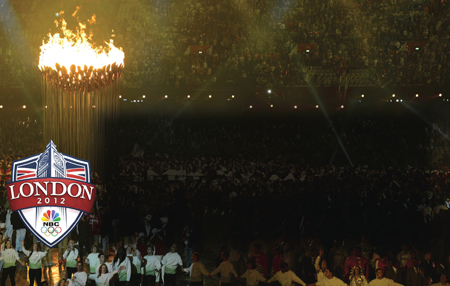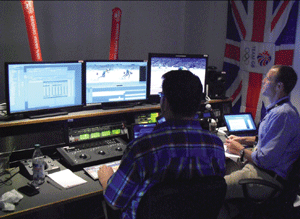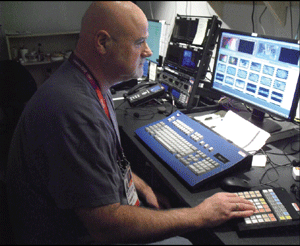NBC and the Olympics: Cards Face Up

LONDON— NBC’s massive London Olympics effort was the fruition of a decade or more of work that saw the network conceive, develop, and deploy multiple strategies to make the production of thousands of hours of coverage possible from a facility that gets built, tuned, used, and torn down all within a few months.
“I think we’ve got most of our cards face up,” said David Mazza, NBC senior vice president of Olympic Engineering, in response to a query about how much “proof-of-concept” testing of developing technologies and techniques took place in London. “I don’t think we had much low profi le testing going on… I think we deployed everything we had.”
Mazza said that many of the designs and systems NBC Olympics had developed and refined over the years since “Olympics 1.0” in Atlanta had evolved in to stable, productive pieces of a complex system needed to achieve a daunting task. In London the production entailed more than 5,000 hours of coverage during the two week event, from July 26-Aug. 11, spread across broadcast and cable outlets, clip-based online coverage in a dozen or so formats for multiple consumer devices, and live streaming of all content. By way of comparison, Atlanta was a 170-hour broadcast with nearly nothing that could be called “new media,” certainly no video.
Elements of NBC’s Olympics technology that have evolved include its “@home” split production between the host city and the United States, an enterprise-level MAM and a “Highlights Factory” for clips-based new media production. Other tools and techniques were new to NBC Olympics but had been refined in test events in the run up to London. Examples include a new 3-/6-channel way of managing stereo and Surround audio production that could become the norm across NBC’s broader sports coverage, and the use of Avid Multi Stream ingest recorders at venue sites.
MAM: BEYOND NEW MEDIA
NBC Olympic’s Enterprise Asset Management workflow has been a decade-long project that has evolved both in its goals and its components. Initially, the system started in SD as a way to track hours of content coming in from Olympic venues, and its proxy-based video was seen as a way to better manage the big HD files on the horizon.

NBC Olympics Editing Room By the big broadcast from Beijing in 2008, the system had progressed to become the production workflow centerpiece of something that was only vaguely in mind a few years before, a massive new media production. London saw the system evolve into a live production tool for both the broadcast and new media parts of the production.
“Finally having the hi- and low-res tied together [in the MAM], which we’ve wanted to do from the very beginning, is a big deal,” said Mazza. He added that the process was helped along tremendously when Avid bought Blue Order, the creator of software which had been an important component of NBC’s system, and which became Interplay MAM. A full year of development of Interplay MAM by NBC staff and Avid developers was key to ironing out the integration, said Mazza.
The professional video industry's #1 source for news, trends and product and tech information. Sign up below.
In London the MAM was location independent— it no longer mattered where a user was retrieving clips from, or where they were being sent. The workflow’s hardware component included Sony XDS XDCAM recorders and EVS servers at ingest, while Harmonic MediaGrids were central to storage and cross-Atlantic file transfers. Avid played its role in craft-level production, and its Interplay MAM desktop interface allowed users to have a single ingest point serving multiple outputs. It provided overarching media management and stored all related metadata.
Darryl Jefferson has been director, Post Production Operations and Highlights Factory Project Manager, NBC Olympics, since the system was deployed in Beijing. He said the real change between Beijing and London was as much cultural as technological.
“As technology guys, I’d love to say we can fix it all with technology,” Jefferson said. “But it’s more cultural—it’s harder to convince the person that has been using tape for their whole career that, ‘It’s OK; you can put that tape down.’
“In Beijing, if you asked an Avid editor hat was going on at the Highlights Factory [new media production using the MAM], they wouldn’t have been able to tell you,” he added.
But in London the Avid editors were getting most of their competition shots from the MAM. They were using the product that used to be mainly for the Highlights Factory. “We made it through a Games and people just used files,” said Jefferson.
GRAPHICS: TRANSCODES & TRANSFERS
Three things were highlights of NBC’s broadcast graphics production, according to Phil Paully, director of Graphics Engineering, NBC Olympics.

NBC Olympics marked the first use of Chyron’s new Desktop Multi-Viewer in a live environment. The first was the use of Brevity Systems software, a graphics transfer and transcoding system which certainly helped the @home infrastructure. Brevity was basically the shipper of all graphics data between London and a 30 Rock supporting facility in New York. At a point a few days before closing ceremonies, around 4 TB of graphics-related data had been sent back to New York, far exceeding the amount sent for the last four Games combined.
Both speed (roughly 6x at prior Games), and transcoding were benefits of the software. “Basically whatever standard, whatever format we’re in, whatever wrapper is on the file doesn’t really much matter,” said Paully. “We tell it what we want it to be at the other end… so when we ship a file from here in 25 [fps], it ends up in a different wrapper in 29.97 in New York.”
And cross-platform transfers were possible— if a graphic is manufactured on a Mac, it goes into the Brevity system and can be transcoded into an EVS file format. Such transfers with Avid formats have worked in tests, but were not done in London. The system also performs lossless compression on the fly, which meant that the more than 4 TB of data actually involved less than 2 TB bandwidth. ���It’s been a tremendous advantage to us here, to say the least,” said Paully.
Another new graphics tech story was the deployment of the Chyron iStore, which basically converts a HyperX 3.1 two-channel graphics system into an independent twochannel clip player. Where NBC has used graphics bugs in the past—which were single channel on a Mac—these are now two channels. “So we can have a moving background for the video wall here, and while that’s going on, on one channel, we can be changing the “Coming Up Next,” the program guides, and the teasers and billboards can play independently,” said Paully.
A third story was the first use of Chyron’s new Desktop Multi-Viewer in a live environment. NBC had three copies in London— one used by Chyron support personnel, the graphics producer copy, and Paully’s copy. The software allows a viewer to see the live canvas of any networked Chyron station and take control of a machine if needed. Diagnostics and software patches or upgrades can be pushed to all the machines in the venues and the International Broadcast Centre.
ON TO SOCHI
London is a modern large city with lots of fibre connectivity and great infrastructure. Although several NBC Olympics staffers have visited Sochi, Russia, at this point the resort town remains a bit of an unknown less than two years before it hosts the 2014 Winter Olympics. There is massive construction taking place, according to Mazza, who has visited Sochi twice.
As for the production of the Games, the weather is always uncertain and often difficult, and dealing with venues split between a downtown and mountain area is always a potential challenge. Sochi is currently constructing a train that promises to keep the transfer time between the two venue clusters to approximately 30 minutes.
The transition between Summer and Winter Olympics is 18 months, much shorter than the 23 months between Winter and Summer Games. The short transition encourages few revolutions in how the production gets done. But the rate of technology change on the consumer end means there is no rest for the production side of a broadcast.
What’s the takeaway?
“I keep thinking and praying that it’s going to get a little bit easier and it never does,” said Mazza. “I guess I should have learned this over the years, but I keep having to relearn it!”

